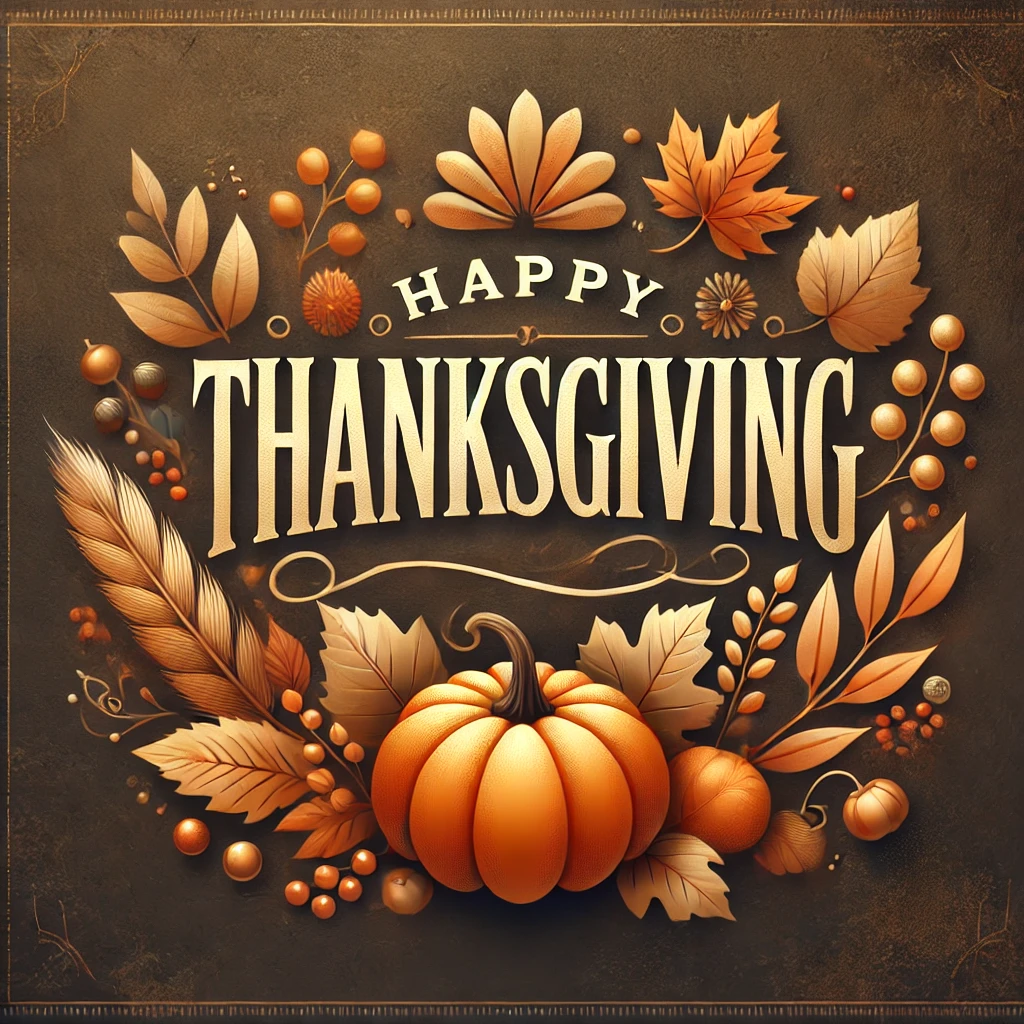Roast Turkey with Herb Butter: A Timeless Recipe Rooted in Tradition
Explore the Rich History of Thanksgiving’s Centerpiece and Master a Classic Recipe with a Flavorful Twist
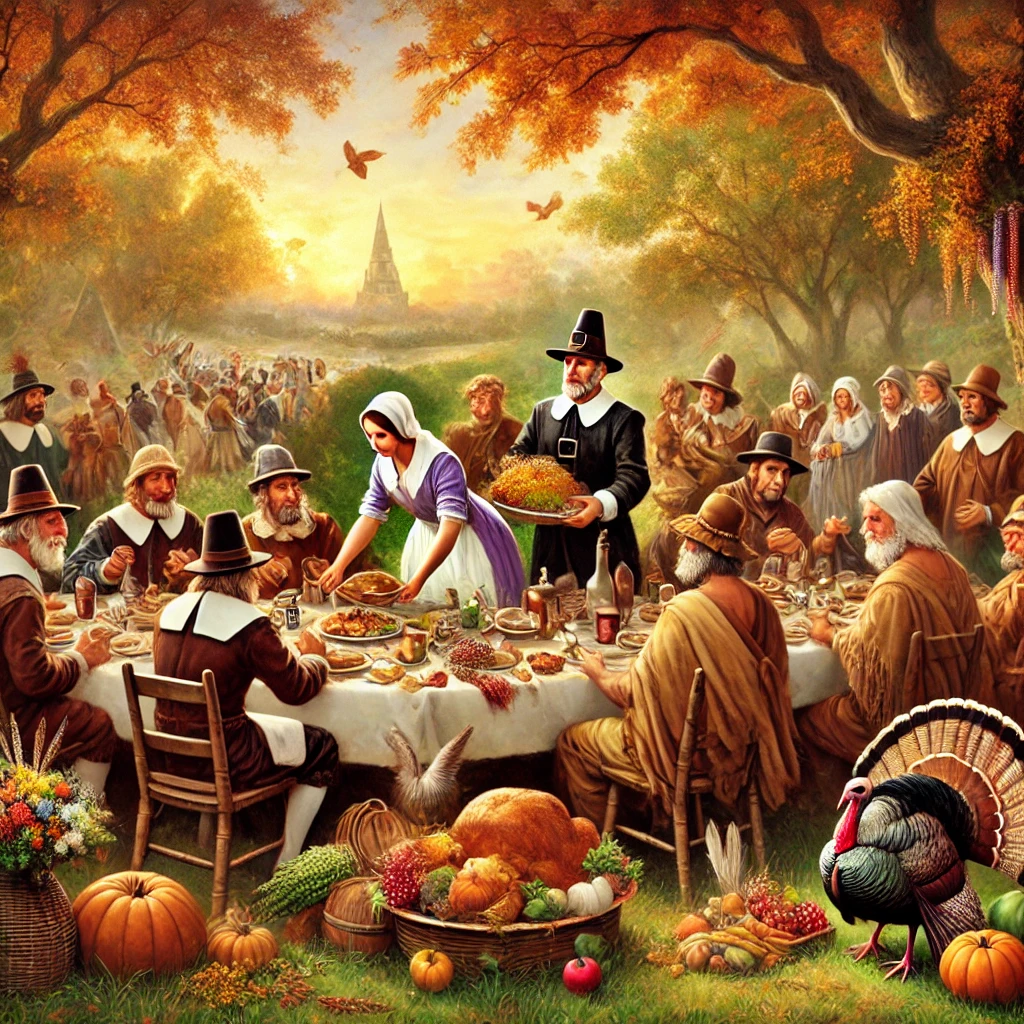
The Thanksgiving Turkey: A Symbol of Gratitude and Tradition
Thanksgiving is a holiday steeped in tradition, family, and, of course, food. Among the many dishes that grace the Thanksgiving table, none is as iconic or as anticipated as the roast turkey. This centerpiece of the feast has become synonymous with the holiday itself, but have you ever wondered how the turkey became such an integral part of Thanksgiving and what it truly symbolizes?
The Historical Origins of the Thanksgiving Turkey
The tradition of Thanksgiving dates back to the early 17th century when the Pilgrims and the Wampanoag Native Americans came together for a three-day feast to celebrate the Pilgrims’ first successful harvest in 1621. While historical records from that first Thanksgiving are sparse, they do mention that the feast included fowl, which could have been ducks, geese, or wild turkeys. However, it wasn’t until much later that turkey became the star of the Thanksgiving table.
The reason turkey became the go-to dish for Thanksgiving has a lot to do with practicality. In the 19th century, when the holiday was formalized, turkey was a common bird in North America and large enough to feed a family. Unlike chickens or cows, which were more valuable for their eggs and milk, turkeys were raised primarily for their meat. This made them an ideal choice for a celebratory meal. By the mid-1800s, the turkey was solidified as the quintessential Thanksgiving dish, largely thanks to the influence of writers like Sarah Josepha Hale, who campaigned for Thanksgiving to become a national holiday and often featured turkey in her descriptions of the feast.
The Symbolism of the Turkey
Beyond its practical advantages, the turkey holds symbolic significance in American culture. Thanksgiving is a holiday centered around themes of gratitude, community, and the celebration of abundance, and the turkey embodies these ideals. As a large bird that can feed many, the turkey represents the bountiful harvest and the generosity of the earth, echoing the spirit of the original Thanksgiving, where food was shared among diverse groups.
Moreover, the act of preparing and sharing a turkey at Thanksgiving has become a symbol of unity and family. The bird’s central place on the table reflects the coming together of loved ones, the giving of thanks for the year’s blessings, and the creation of memories that will be cherished for generations. The turkey, with its golden, crispy skin and succulent meat, serves as a reminder of the warmth and togetherness that Thanksgiving fosters.
The Evolution of the Thanksgiving Turkey
While the traditional roast turkey remains the centerpiece of many Thanksgiving dinners, the ways in which it is prepared have evolved over the years. From herb-butter roasted turkeys to deep-fried and smoked variations, each family has its own take on this classic dish, reflecting regional flavors and personal tastes. Even the sides and accompaniments that go with the turkey have diversified, yet the bird itself remains a constant, anchoring the meal in tradition.
In recent years, some have begun to explore alternative main dishes, either due to dietary preferences or a desire to break from tradition. However, the turkey still reigns supreme as the emblem of Thanksgiving, symbolizing not only the historical roots of the holiday but also its enduring legacy as a time for reflection, gratitude, and sharing.
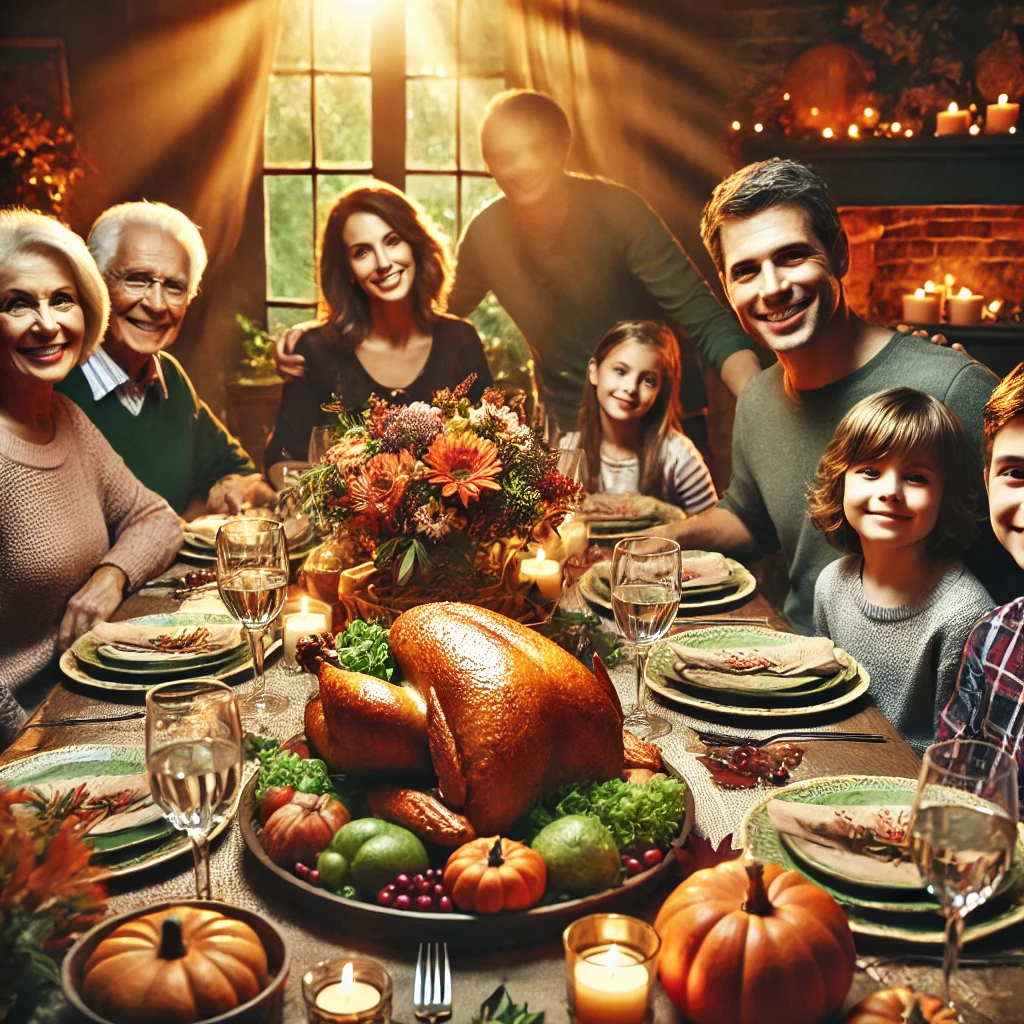
A Timeless Tradition
The Thanksgiving turkey is more than just a dish; it is a symbol of the holiday’s rich history and the values it represents. As families gather around the table each year, the turkey stands as a reminder of the importance of coming together, giving thanks, and celebrating the abundance of life. Whether roasted, fried, or even veganized, the turkey remains at the heart of Thanksgiving, a timeless tradition that continues to bring people together in the spirit of gratitude.
So, as you carve into your Thanksgiving turkey this year, take a moment to reflect on its journey from the wilds of North America to the center of your holiday table. It’s not just a meal; it’s a piece of history, a symbol of unity, and a testament to the enduring spirit of Thanksgiving.
Roast Turkey with Herb Butter
Ingredients:
- 1 whole turkey (12-14 pounds), thawed if frozen
- 1/2 cup unsalted butter, softened
- 3 tablespoons fresh rosemary, finely chopped
- 3 tablespoons fresh thyme, finely chopped
- 3 tablespoons fresh sage, finely chopped
- 3 cloves garlic, minced
- 1 lemon, zested and quartered
- 1 onion, quartered
- 2 carrots, peeled and cut into large chunks
- 2 celery stalks, cut into large chunks
- Salt and black pepper, to taste
- 1 cup chicken broth
- 2 tablespoons olive oil
Instructions:
Preheat the Oven:
Preheat your oven to 325°F (165°C).
Prepare the Herb Butter:
In a small bowl, combine the softened butter, chopped rosemary, thyme, sage, minced garlic, and lemon zest.
Mix until well combined.
Prepare the Turkey:
Remove the turkey from its packaging and discard the giblets and neck from the cavity.
Pat the turkey dry with paper towels, ensuring it’s completely dry inside and out.
Season the Turkey:
Gently loosen the skin over the turkey breast by sliding your fingers between the skin and the meat, being careful not to tear the skin.
Rub the herb butter generously under the skin, making sure to cover the breast and legs.
Rub any remaining herb butter on the outside of the turkey.
Stuff the Cavity:
Place the lemon quarters, onion, carrots, and celery into the cavity of the turkey. These will help flavor the turkey from the inside as it cooks.
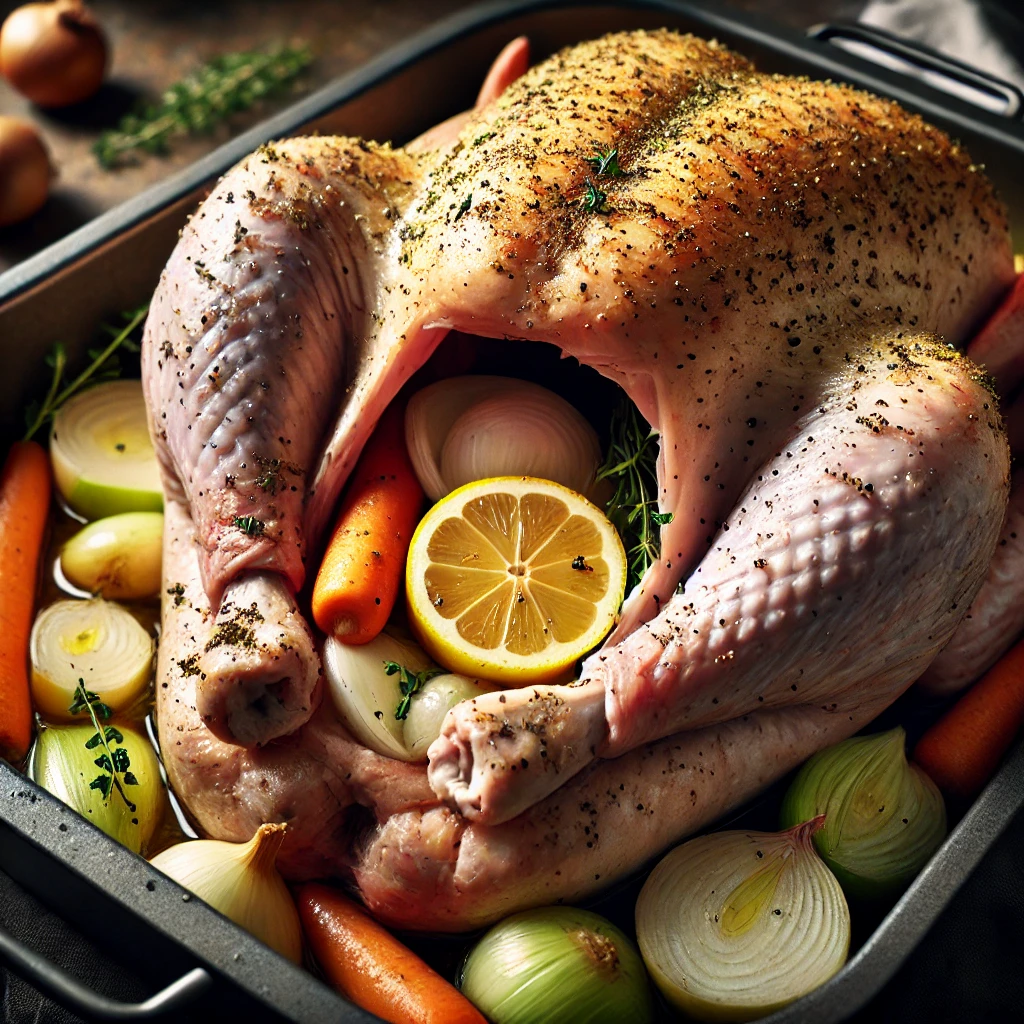
Season the Exterior:
Drizzle the turkey with olive oil and season generously with salt and black pepper on all sides.
Roast the Turkey:
Place the turkey on a roasting rack set in a large roasting pan.
Pour the chicken broth into the bottom of the pan to help keep the turkey moist during cooking.
Cooking Time:
Roast the turkey in the preheated oven. For a 12-14 pound turkey, roast for about 3 to 3.5 hours, or until the internal temperature reaches 165°F (74°C) in the thickest part of the thigh without touching the bone.
Baste Occasionally:
Baste the turkey with the pan juices every 30-45 minutes to ensure it stays moist and develops a beautiful golden-brown color.
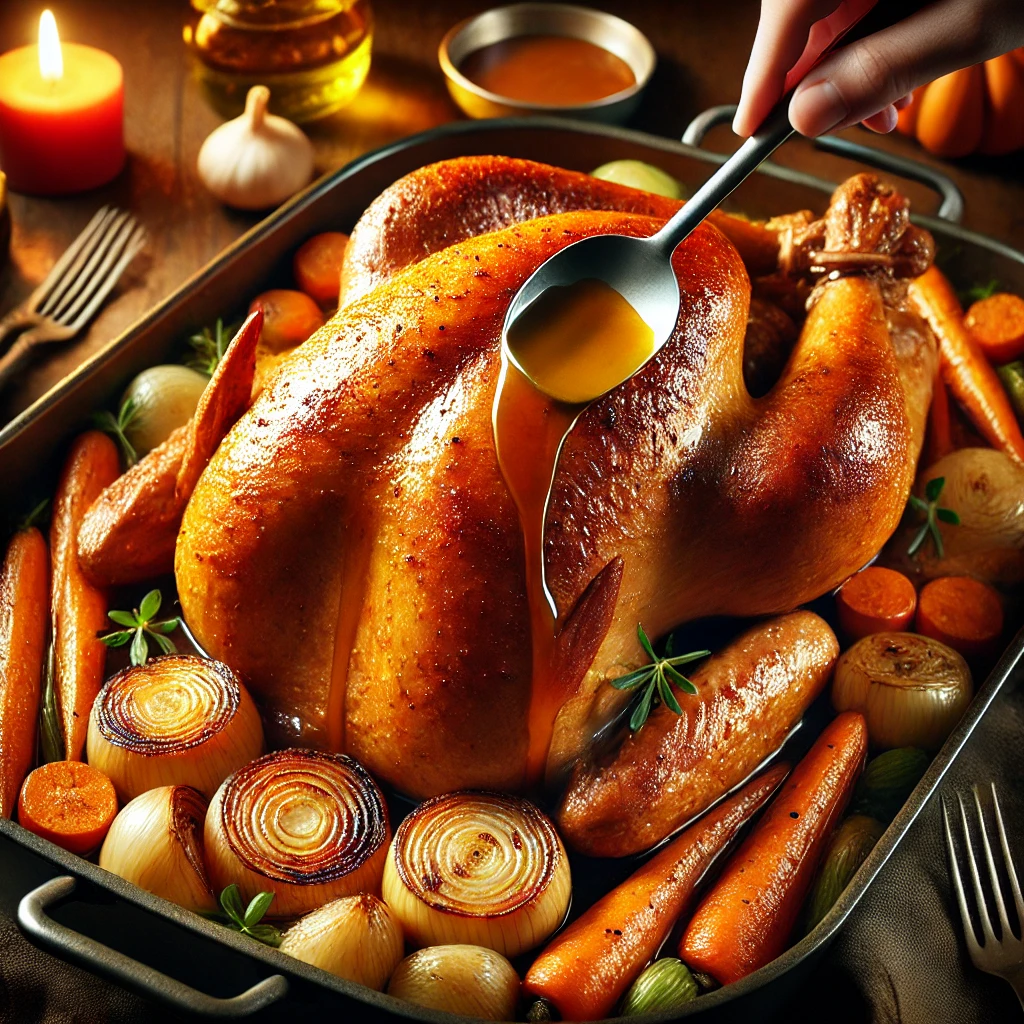
Rest the Turkey:
Once the turkey reaches the correct temperature, remove it from the oven and let it rest for 20-30 minutes before carving. This allows the juices to redistribute throughout the meat, ensuring a juicy turkey.
Carve and Serve:
Carve the turkey and serve with your favorite side dishes.
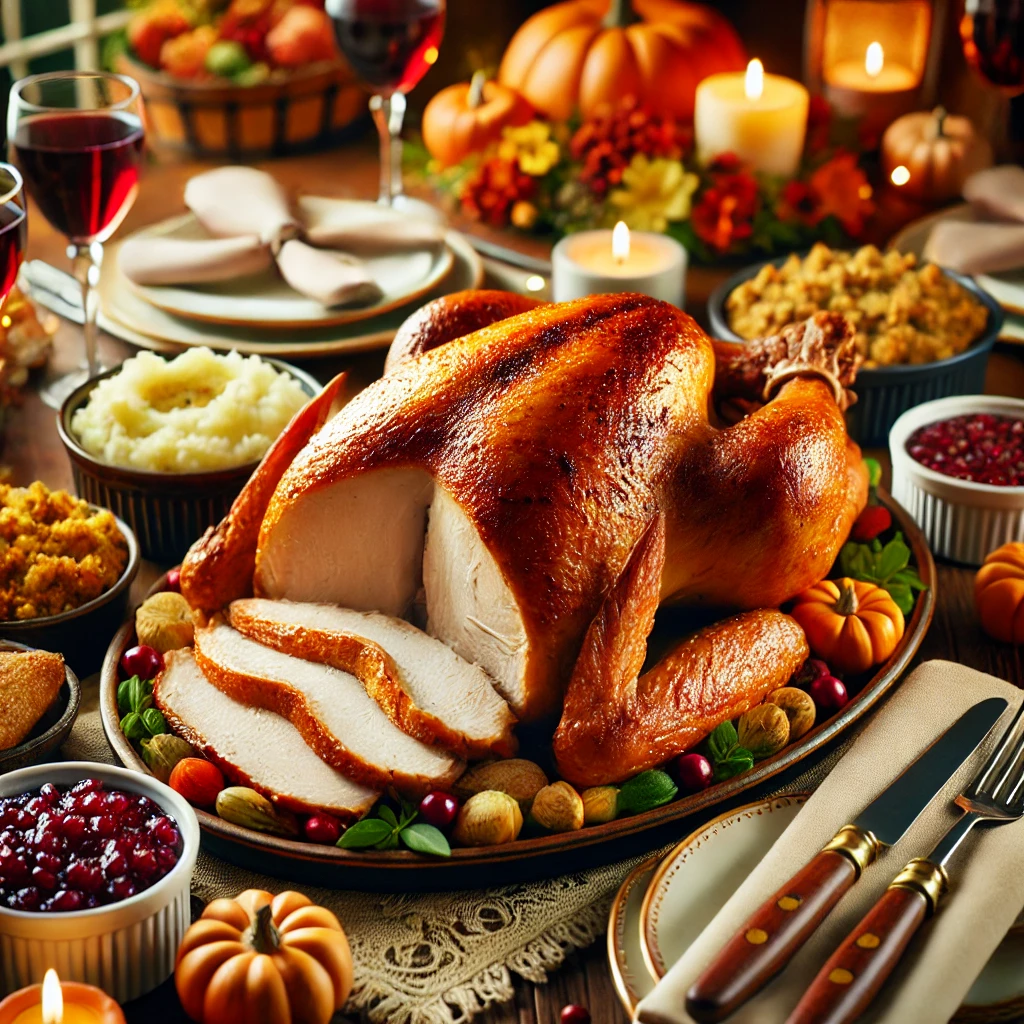
As the golden turkey graces your Thanksgiving table, surrounded by a bounty of flavorful side dishes, it becomes more than just a meal—it’s a symbol of tradition, togetherness, and gratitude. This Roast Turkey with Herb Butter recipe not only brings rich, savory flavors to your holiday feast but also connects you with a timeless culinary heritage. Whether you’re gathering with loved ones or savoring the moment solo, this dish promises to make your Thanksgiving celebration memorable and delicious. Enjoy every bite, and may your holiday be filled with warmth and joy.
Yield and Serving Size:
- Yield: Serves approximately 10-12 people
Nutritional Facts (per serving, assuming 12 servings):
- Calories: 420 kcal
- Total Fat: 26g
- Saturated Fat: 10g
- Trans Fat: 0g
- Cholesterol: 175mg
- Sodium: 380mg
- Total Carbohydrates: 2g
- Dietary Fiber: 0g
- Sugars: 1g
- Protein: 44g
Note: Nutritional values are estimated based on standard ingredients and serving sizes. The exact values may vary depending on specific ingredients and portion sizes.
